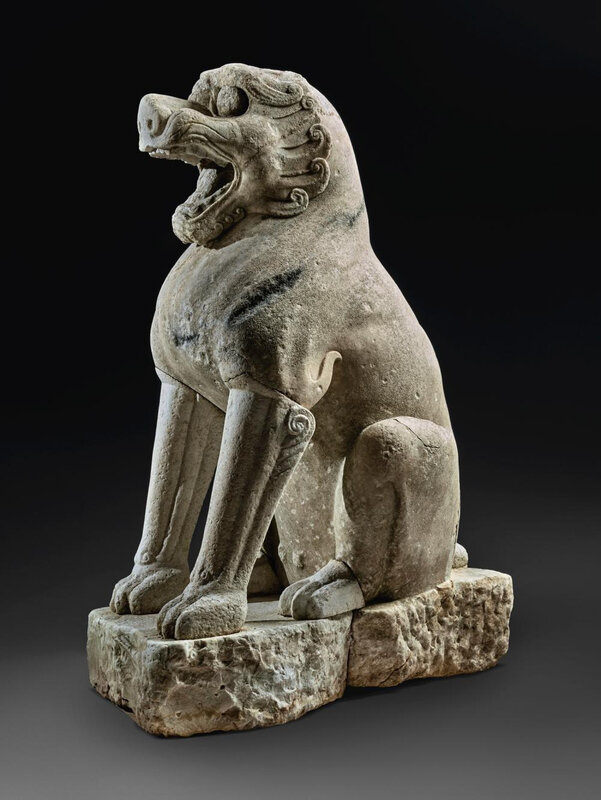A magnificent large white marble lion, Northern Qi dynasty (550-577)
Lot 132. A magnificent large white marble lion, Northern Qi dynasty (550-577). Height 40 3/4 in., 103.6 cm. Estimate: 400,000 — 600,000 USD. Courtesy Sotheby's.
stately modeled, the mighty beast carved seated on its haunches with forelegs outstretched and powerful paws firmly planted, its head held up and facing forward, shown with a fierce expression, the mouth open in a roar below large rounded eyes and thick bushy brows, all framed by a long mane falling into spiraling curls, its muscular back with two gently raised ridges, extending to a tail curling over the right, all raised on a rectangular base, the stone of mottled gray-buff color.
Collection of Stephen Junkunc, III (d. 1978).
Exhibited: Treasures of Chicago Collectors, Art Institute of Chicago, Chicago, 1961.
Note: This magnificent lion is portrayed in a dramatic pose. Although seated, its bulging, tense muscles and menacing expression suggest a readiness to move. The carver’s confidence with the stone medium is seen in the rendering of the muscular body and in the detailed carving of the nose and mouth, which contrast the linear swirls of the animal’s mane. Free-standing sculptures of stone lions were seldom made in the Northern Qi dynasty, and those of such large size and made from marble are especially rare.
In addition to their placement along spirit roads leading to tombs, lions also appear in Buddhist contexts and it is more probable that the present example belongs to this tradition. The Gao family that founded the Northern Qi dynasty were active patrons of Buddhism, and sponsored the building of numerous temples. Jinhua Chen in ‘Buddhism under the Northern Qi’, Echoes of the Past, Smart Museum of Art, The University of Chicago, Chicago, 2010, p. 3, expounds on the role of Northern Qi rulers in the spread of Buddhism. Emperor Wenxuan (550-559) is said to have declared to the Buddhist leader Sengchou (480-560) his intention to offer a third of state revenues to the Buddhist establishment. Daxuan Xu’s biography of Sengchou further records the presence of four-thousand temples in the Northern Qi capital alone.
The earliest anthropomorphic images of the Buddha from Mathura in northern India, and from Gandhara in Pakistan, are often flanked by pairs of lions. A symbol of royalty and power in India, the two lions represent the royal origins of the Buddha and are emblematic of his immense spiritual power. As Buddhism spread throughout China under the patronage of the foreign Tuoba rulers in the Northern Wei and continued to receive imperial sponsorship in the Northern Qi, the faith was integrated into Chinese ideology, practices and iconography. This syncretism is displayed in sculptures of lions, which in China are rendered with menacing features, and were used to flank the Buddha and to protect the entrance of temples and sacred spaces.
Stylistically this lion marks a shift from the more abstract Buddhist animal sculptures of the preceding Northern Wei. An attempt at naturalism is displayed in the tensed muscular body of the animal, while the rendering of the animal’s hair in finely combed swirls differs significantly from the carving of deep parallel ridges in the Northern Wei versions. A Northern Wei lion in the Guyangdong cave at Longmen, Henan province, is illustrated in situ in Zhongguo meishu quanji. Diaosu bian [Complete collection of Chinese art, sculpture. Longmen stone sculpture], vol. 11, Shanghai, 1988, pl. 6, see also a smaller lion sold in these rooms, 3rd June 1985, lot 25.
The remains of two Northern Qi lions used as pillar supports at the entrance of Southern Xiangtangshan Caves, are illustrated in situ in Xiangtangshan shiku [Xiantangshan caves], Beijing, 2003, pl. 47; together with three free-standing lions, pls 98-100. A much smaller lion with its mouth closed, from the Sakamoto Gorō Collection, was sold in our Hong Kong rooms, 8th October 2013, lot 128. Compare also a smaller lion attributed to the Northern Wei dynasty, but featuring a related mane, in the Asian Art Museum of San Francisco, illustrated in René-Yvon Lefebvre d’Argencé, Chinese, Korean and Japanese Sculpture in the Avery Brundage Collection, San Francisco, 1974, pl. 42.
Sotheby's. Junkunc: Arts of Ancient China, New York, 19 march 2019, 10:00 AM

/https%3A%2F%2Fprofilepics.canalblog.com%2Fprofilepics%2F1%2F0%2F100183.jpg)
/https%3A%2F%2Fstorage.canalblog.com%2F03%2F02%2F119589%2F96711876_o.jpg)
/https%3A%2F%2Fstorage.canalblog.com%2F11%2F31%2F119589%2F94773502_o.jpg)
/https%3A%2F%2Fstorage.canalblog.com%2F20%2F83%2F119589%2F94772815_o.jpg)
/https%3A%2F%2Fstorage.canalblog.com%2F26%2F72%2F119589%2F75604929_o.jpg)
/https%3A%2F%2Fstorage.canalblog.com%2F59%2F60%2F119589%2F26458628_o.jpg)




/image%2F1371349%2F20240406%2Fob_625d1f_435265227-1644758039627542-32064852869.jpg)
/image%2F1371349%2F20240301%2Fob_d5f868_430943360-1625861868183826-87537067406.jpg)
/http%3A%2F%2Fstorage.canalblog.com%2F30%2F00%2F119589%2F129121612_o.jpg)
/http%3A%2F%2Fstorage.canalblog.com%2F75%2F15%2F119589%2F129091868_o.jpg)